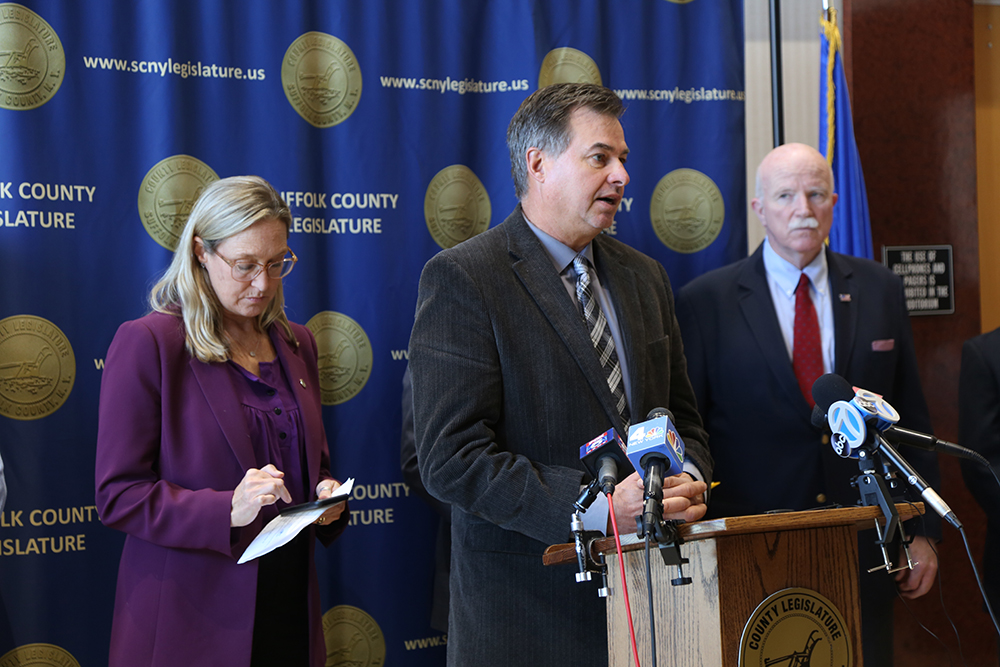‘Alarm has sounded’ after scallop die-off of 95 to 100% in some areas

After a “near-unprecedented” scallop die-off in Peconic Bay, Suffolk County legislators on Thursday outlined efforts underway to investigate the cause.
“The alarm has sounded,” Suffolk County Presiding Officer DuWayne Gregory said at a press conference in Smithtown.
Experts with Peconic Estuary Program, Cornell Cooperative Extension and the state Department of Environmental Conservation have been working together to try to understand the problem, he said.
“We are seeing reports of die-off of 95%, up to 100% in some pockets,” Mr. Gregory said.
Steven Tettelbach, a shellfish ecologist with Cornell Cooperative Extension, described the die-off as one of the most serious the East End has seen since the mid-1980s.
“We have done extensive population surveys of the scallops and confirmed what baymen had rumored, that the die-off was up to 100% in some locations,” he said. “Going forward, we need to address that and hopefully mitigate some of the die-off and the repercussions to the fishermen, especially.”
He said they believe the die-off was the result of a combination of “high water temperature and low dissolved oxygen levels, in conjunction with the spawning of the adult scallops.”
Both of those suspected factors may be linked to climate change, Mr. Tettelbach said. However, he pointed out, this year does not hold the record for warmest water temperatures compared to the last five years. In 2018, he said, the water was warmer. Mr. Tettelbach also mentioned that oyster growers this year say 2019 has been one of their best harvesting years. Scallops, he said, are very environmentally-sensitive compared to certain other species.
“We think that the timing of scallop reproduction, which is actually a very physiologically stressful event for scallops, may have been more aligned with the highest water temperatures,” he said. “But the water temperatures in Flanders Bay and the western part of Peconic Bay this year were over 85 degrees and that’s getting very close to the lethal limit for bay scallops.”
If this is climate change, he said, the East End is at its mercy.
“We have to do what we can to save what we have left here,” he said.
Members of Cornell Cooperative Extension are collecting data on water quality, temperature records from various locations within the Peconic Estuary and targeted data from other scientific partners. Members of the Peconic Estuary Program are also compiling and reviewing similar data.
Sarah Schaefer, an environmental analyst and program coordinator for Peconic Estuary Program, said Thursday that “the scallop has been a longstanding icon.”
It is critical, she said, that restoration and water quality monitoring efforts continue in the watershed.
Ms. Schaefer said Peconic Estuary Program will be convening a scallop technical review committee in the coming weeks. Mr. Tettelbach added that Cornell Cooperative is working to protect the remaining scallop population. His group will be meeting with members of the East End Seaport Museum in Greenport Thursday night to plan out a potential transfer of Peconic scallops that are located in areas where they have low chance of survival. Cornell Cooperative is also trying to obtain samples of live scallops to investigate the level of toxins in their tissues and check to see if disease might play a role. He is doubtful of that, he said, because there are still plenty of juvenile scallops in the bays.
“The risk of the population is if the juveniles get harvested,” he said. “And that’s been a big issue in the last couple of years is illegal harvesting of juvenile scallops … If it takes shutting down the fishery then that may be what it would take. It has happened in the past and it’s happened a lot in the past two years.”
Mr. Tettelbach did say that closing the fishery now might be a premature move.
Legislator Al Krupski (D-Cutchogue) said scalloping is a real part of the local economy and culture, adding that it is difficult to calculate the financial impact because many people go scalloping casually, without keeping records. Legislator Bridget Fleming (D-Sag Harbor) said the die-off may be a potentially catastrophic monetary hit on the industry.
“The experts are predicting more than a million dollars,” she said. “It may be well above that because we do have the family baymen … but also the retailers and the restaurant industries.”
Nov. 4 marked the first day of scallop season. Many local baymen predicted in the days leading up to Nov. 4 that the a bad season was in the future. Those thoughts were confirmed on opening day.
Ms. Fleming added that scallops are integral to the economic viability of North and South Fork tourism, urging people to back data because “science matters.”
Mr. Krupski said one positive is that there are many bugs, or juvenile scallops, in the bay now, of all different forms and sizes.
“Hopefully, that will bode well for next season,” he said.
Photo caption: Legislator Al Krupski. (Credit: Mahreen Khan)









